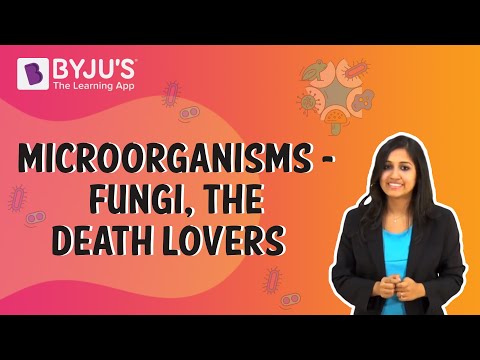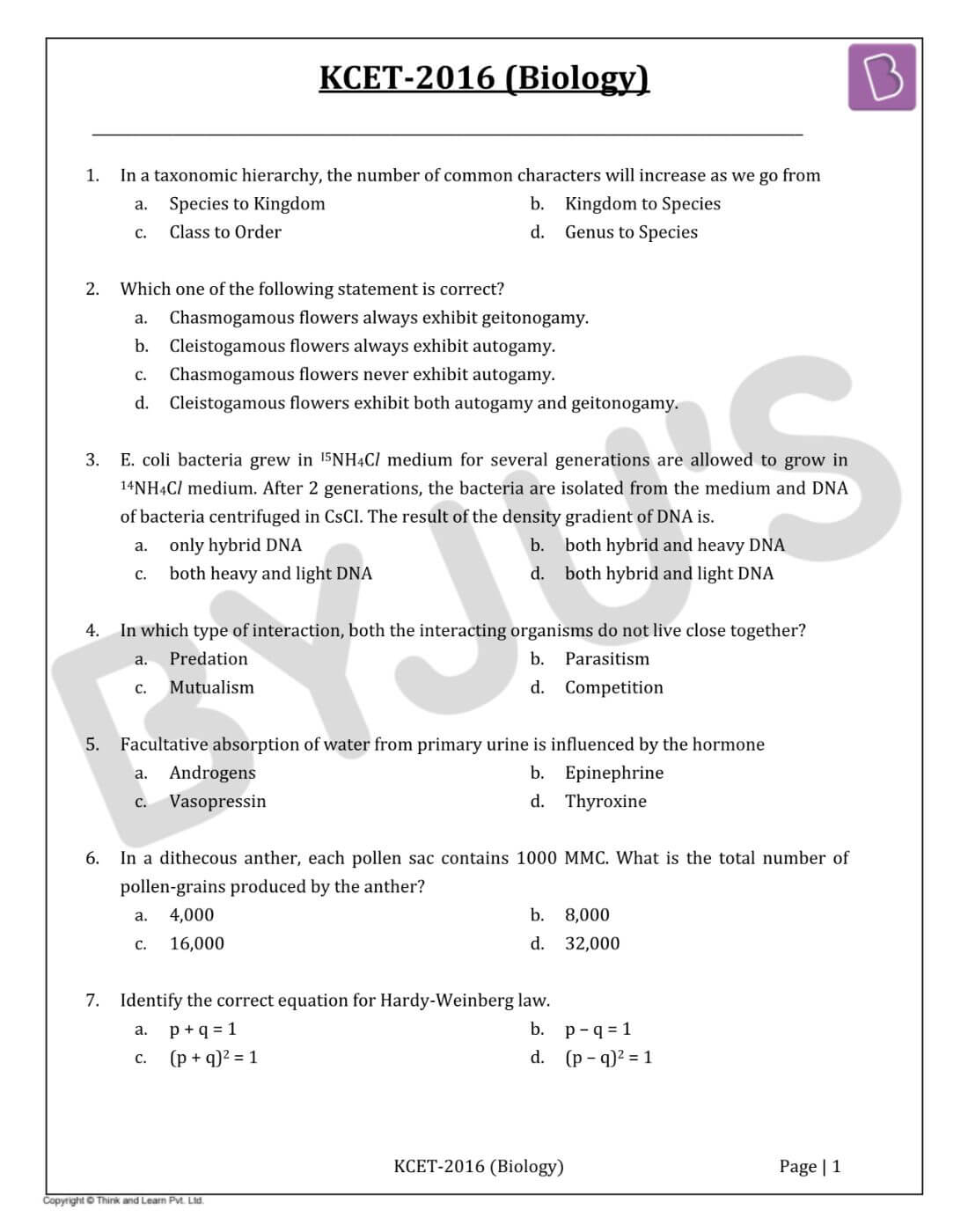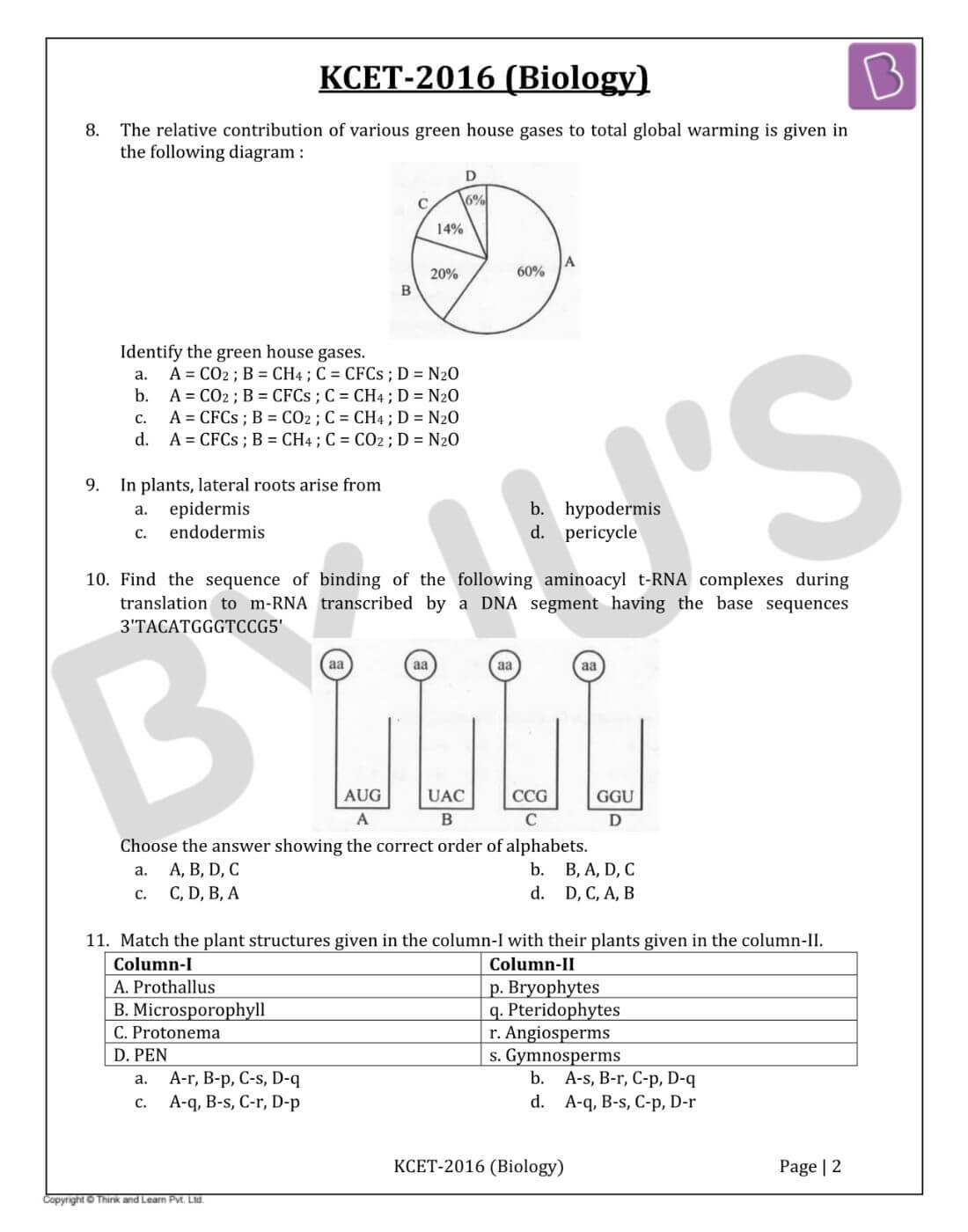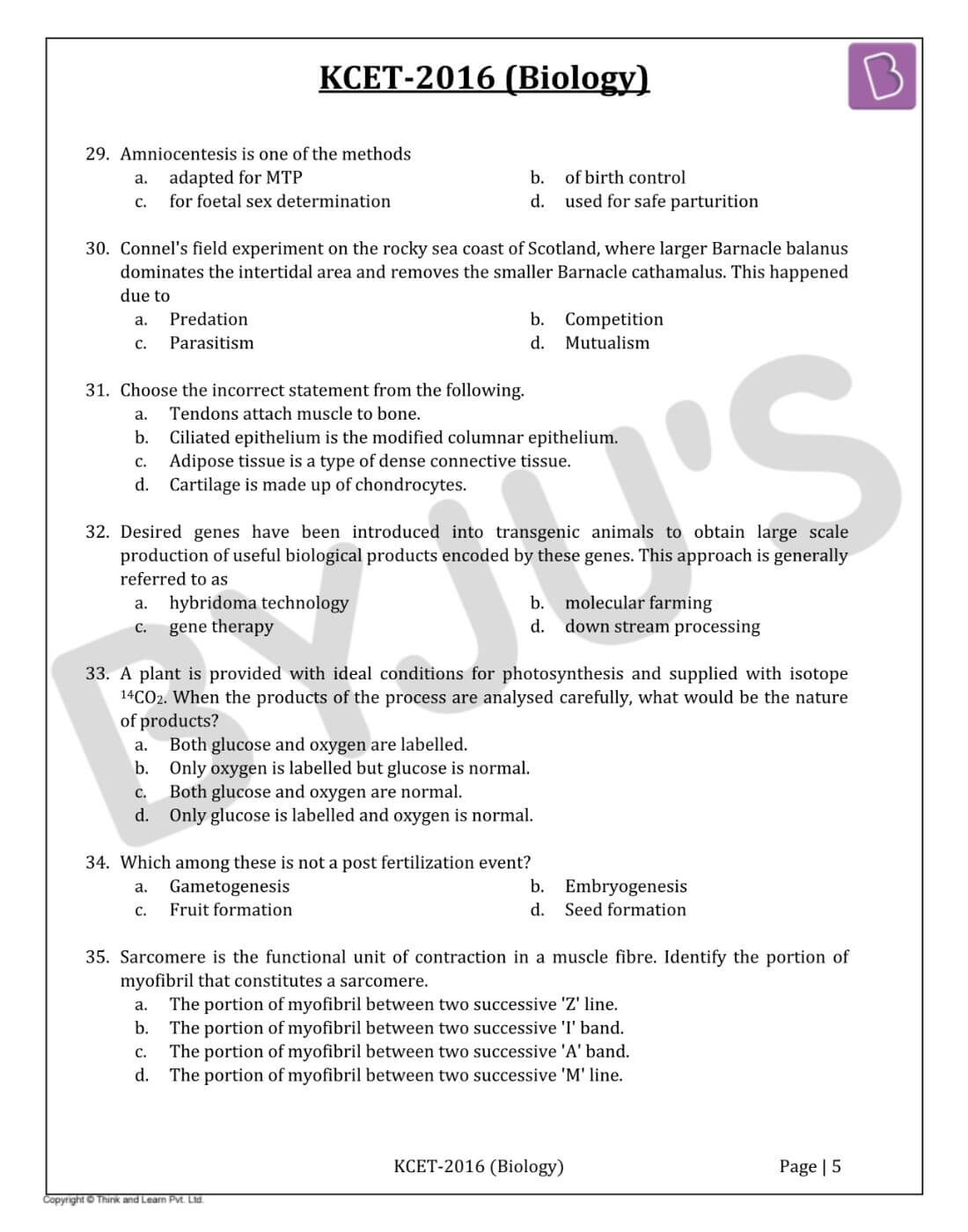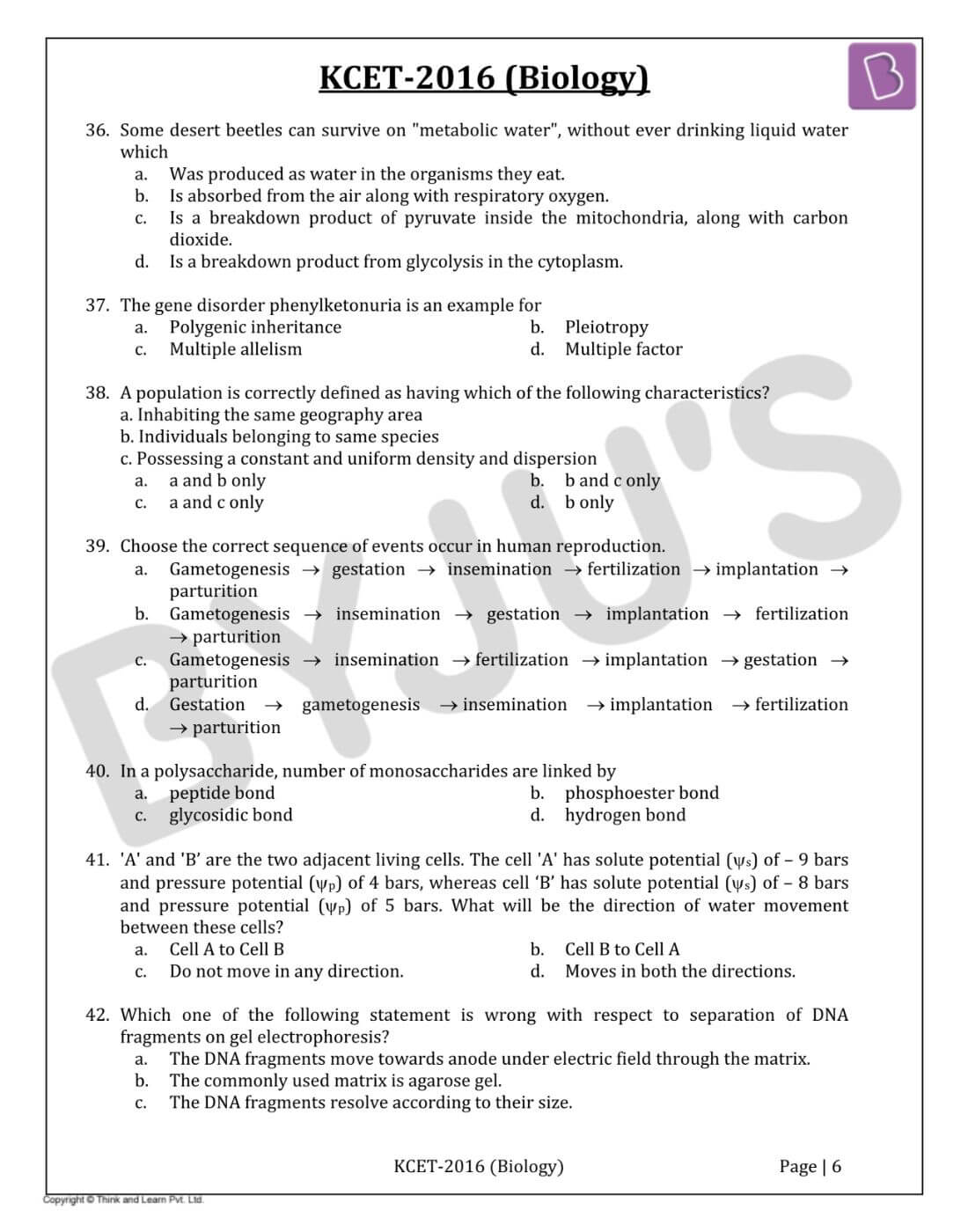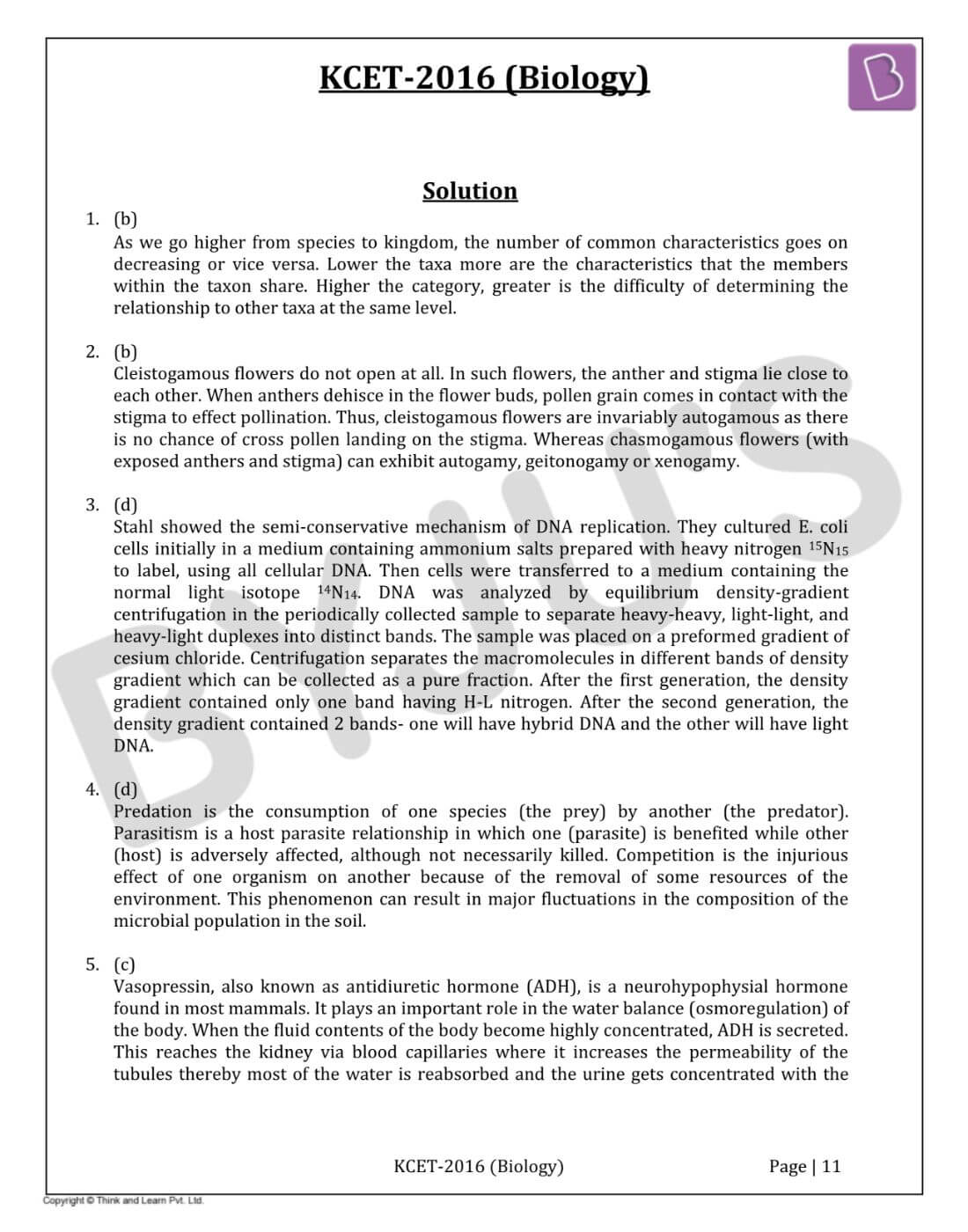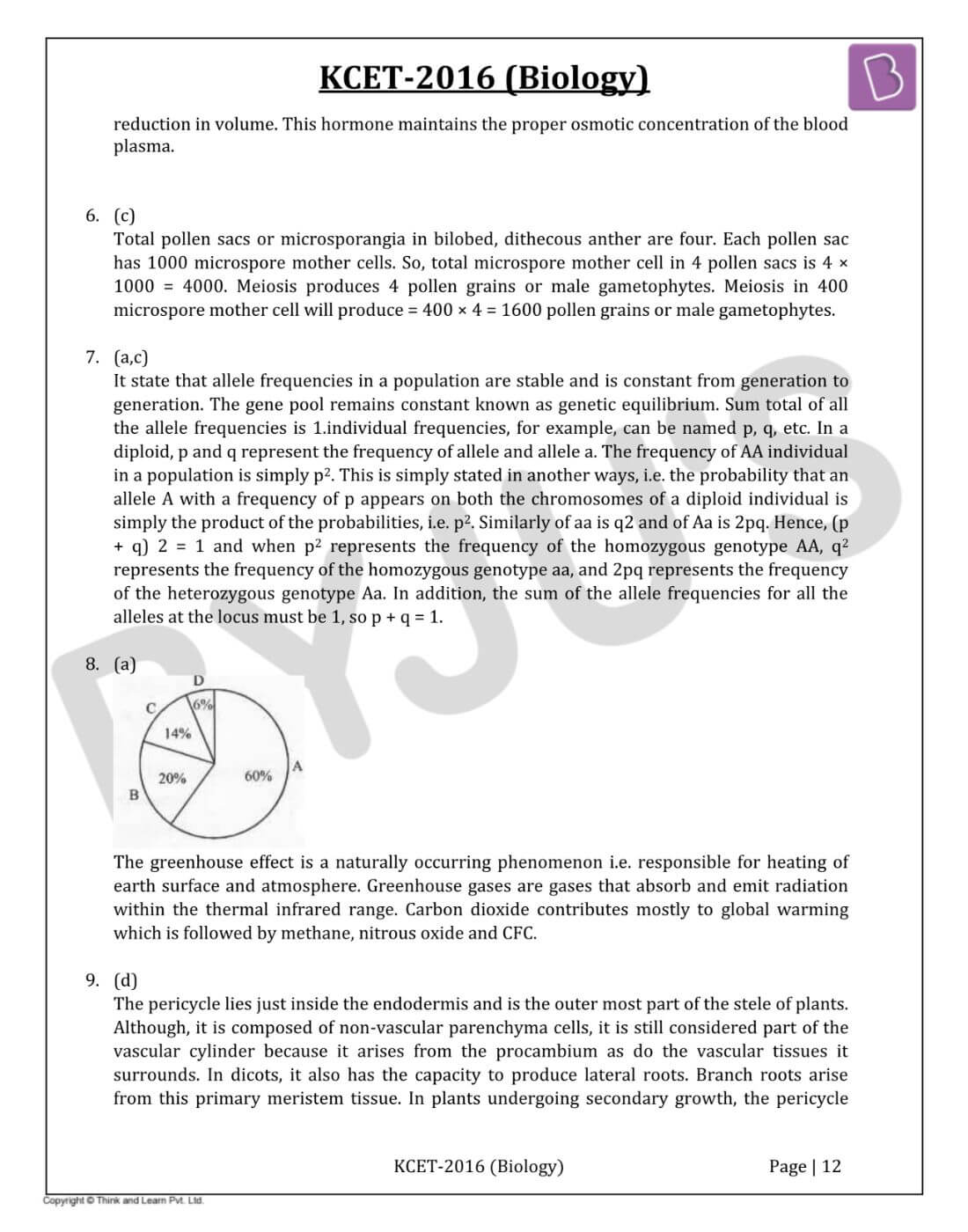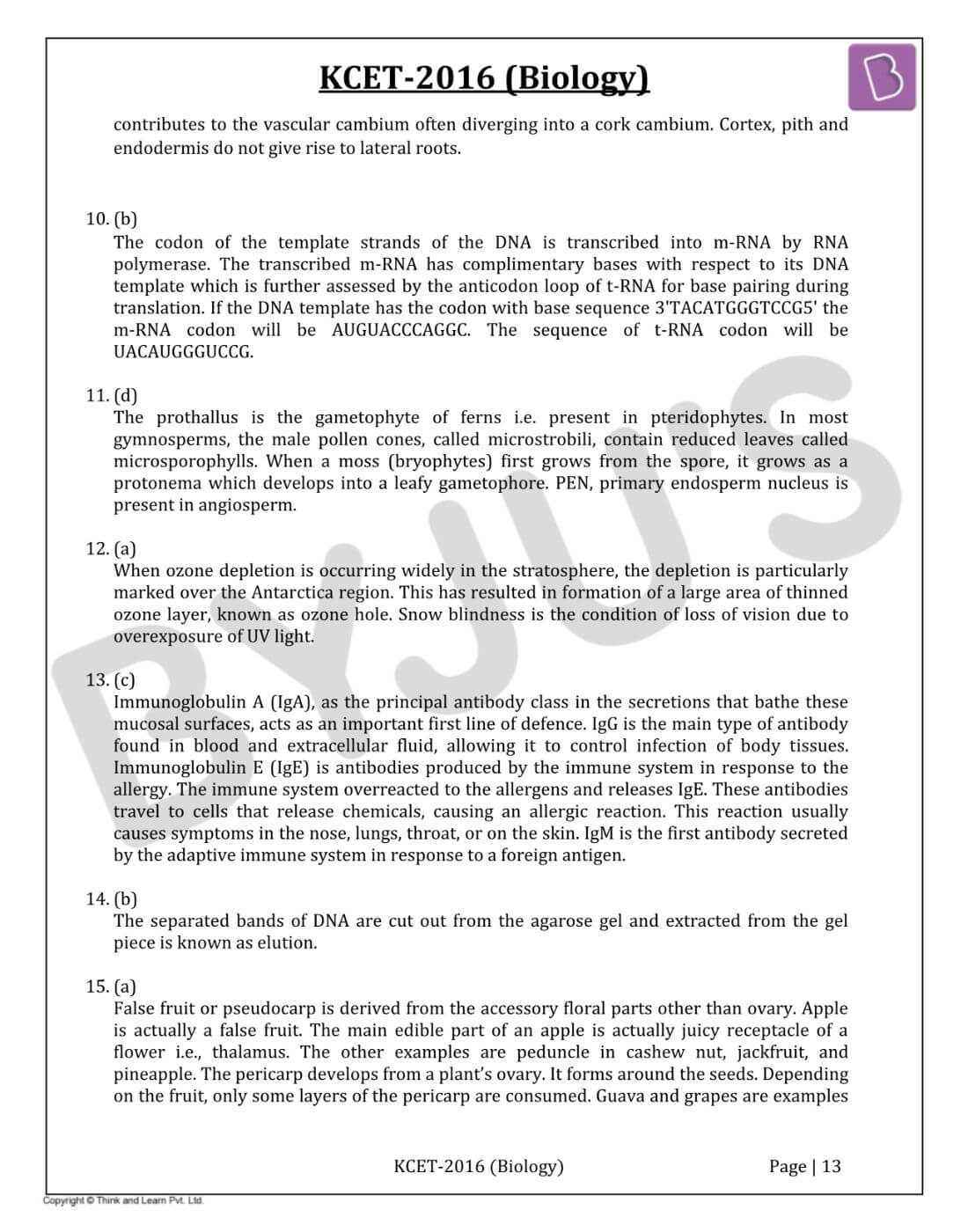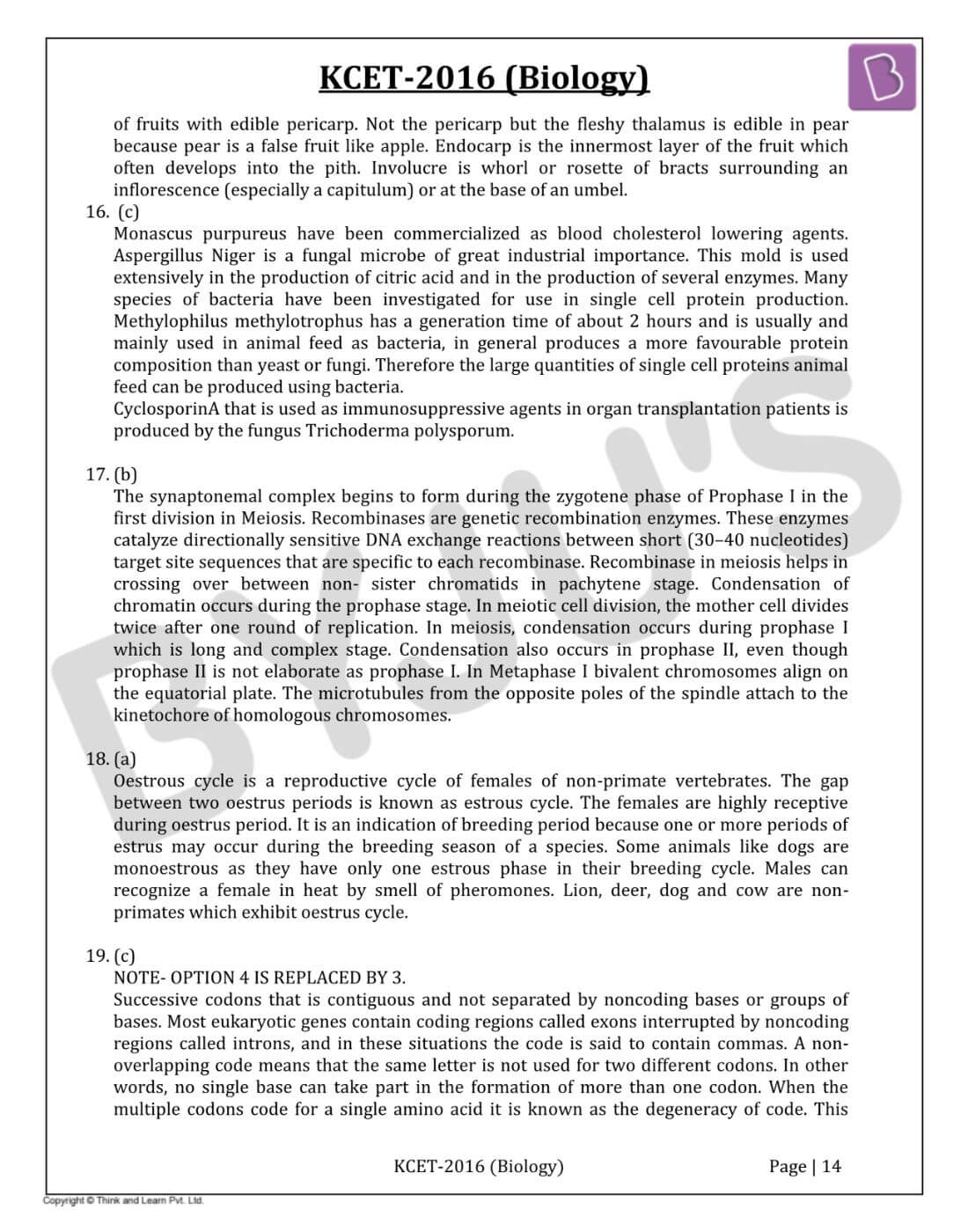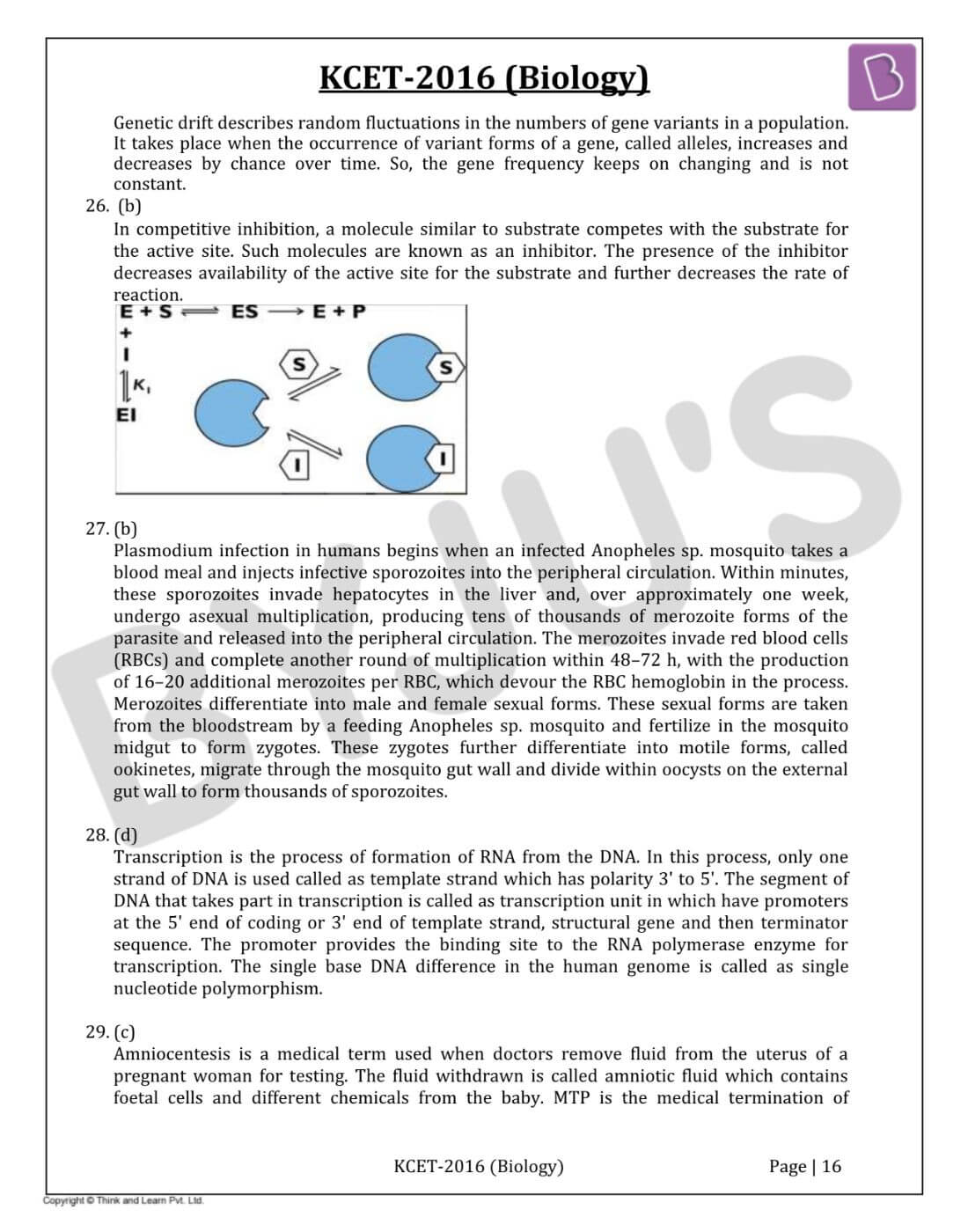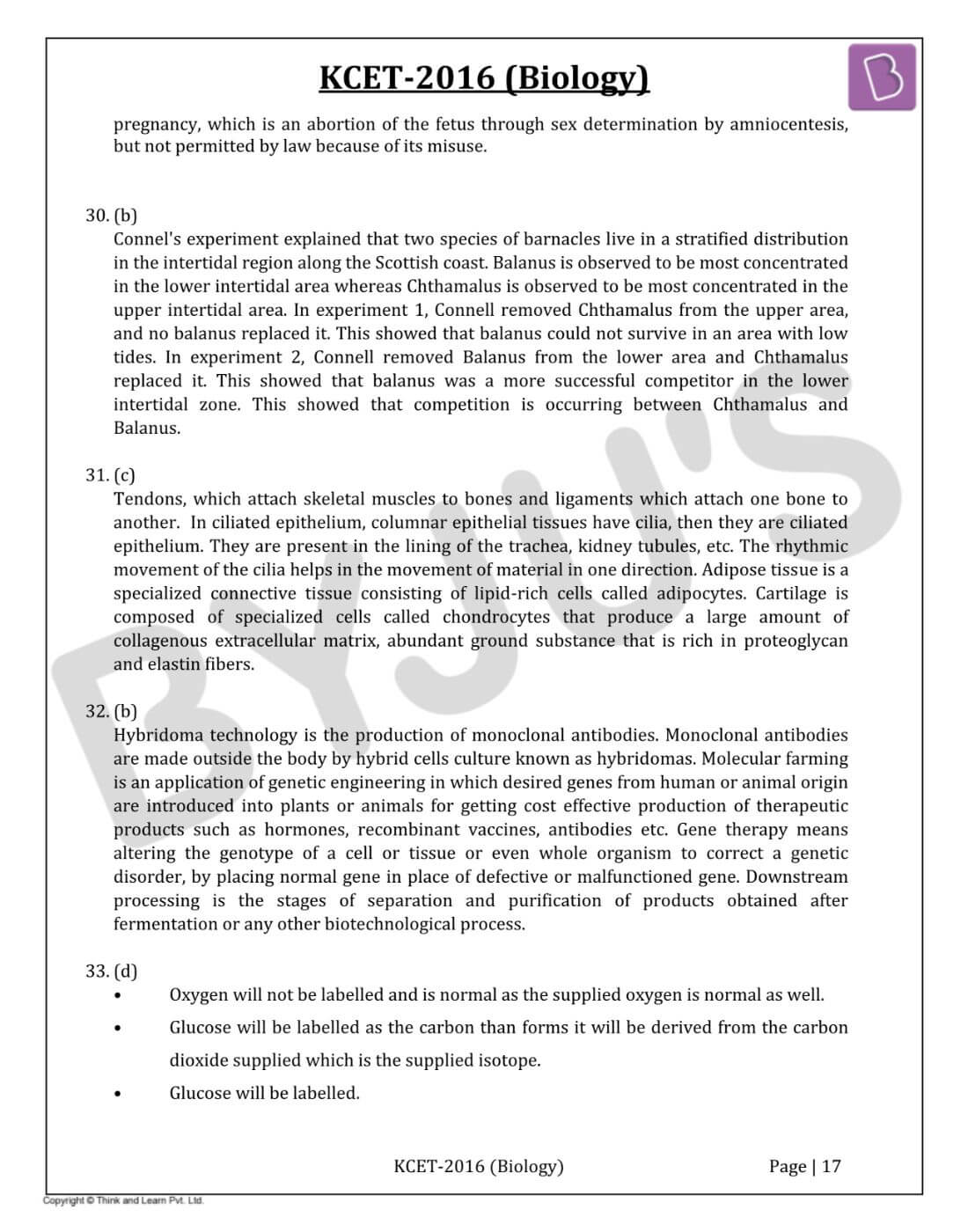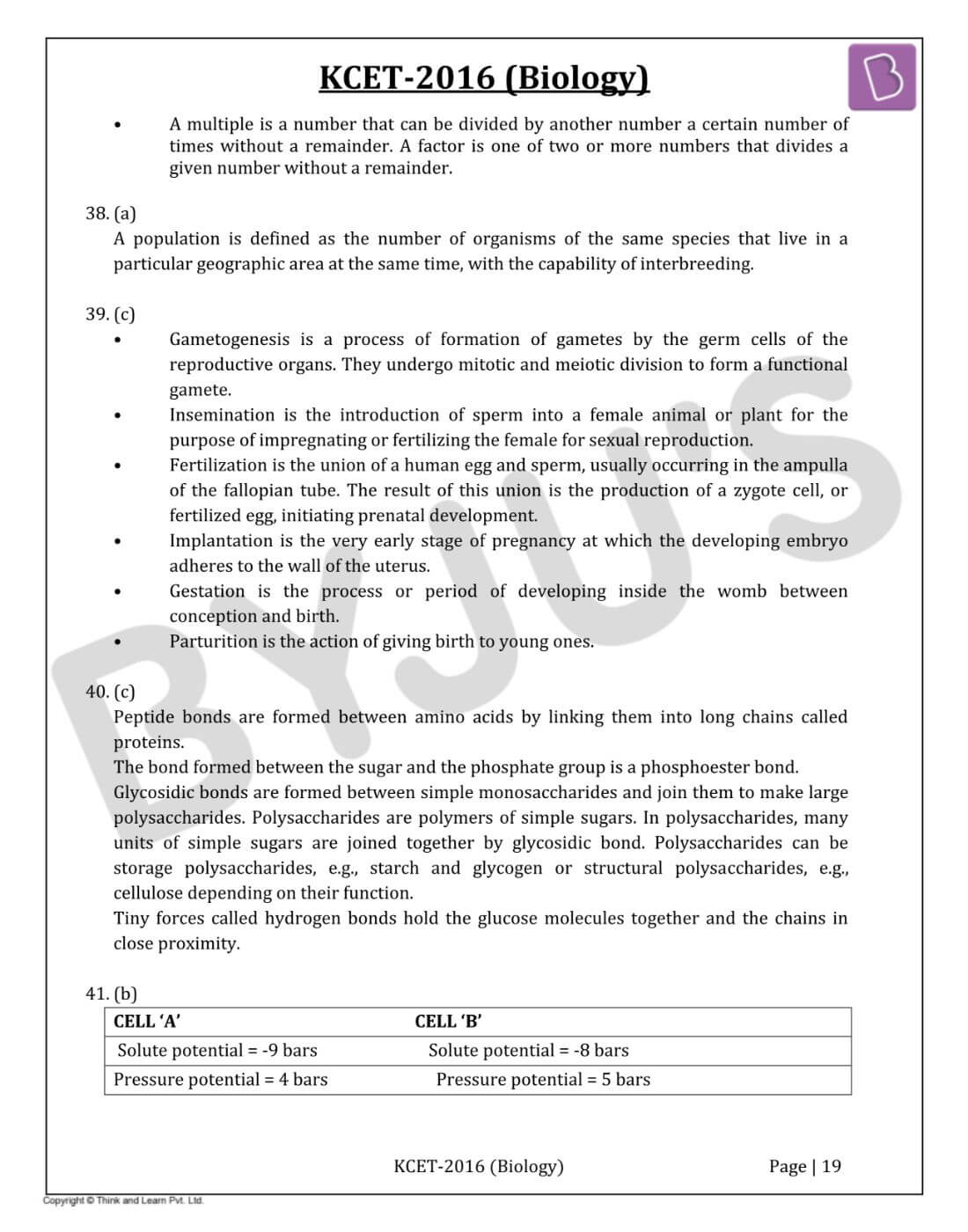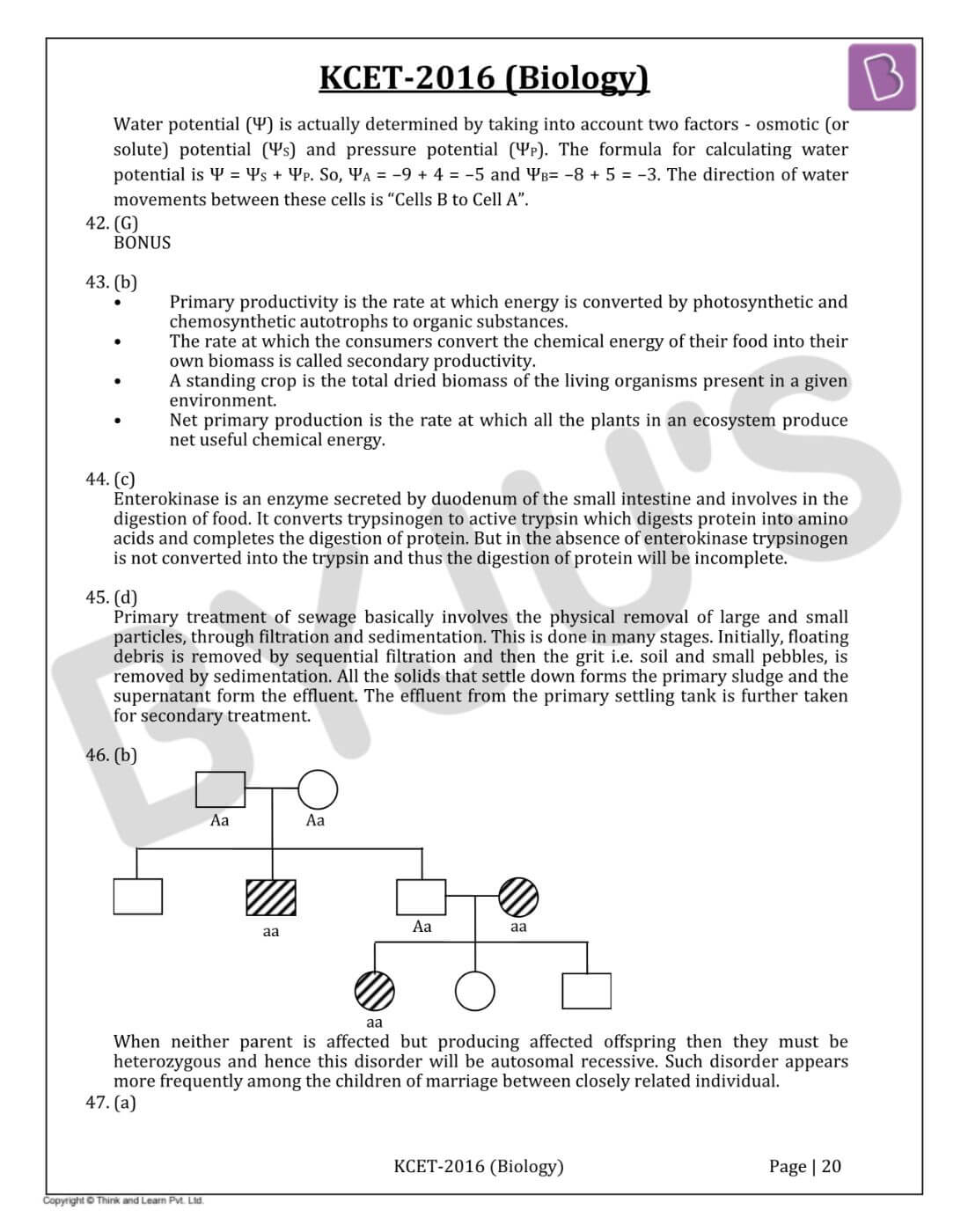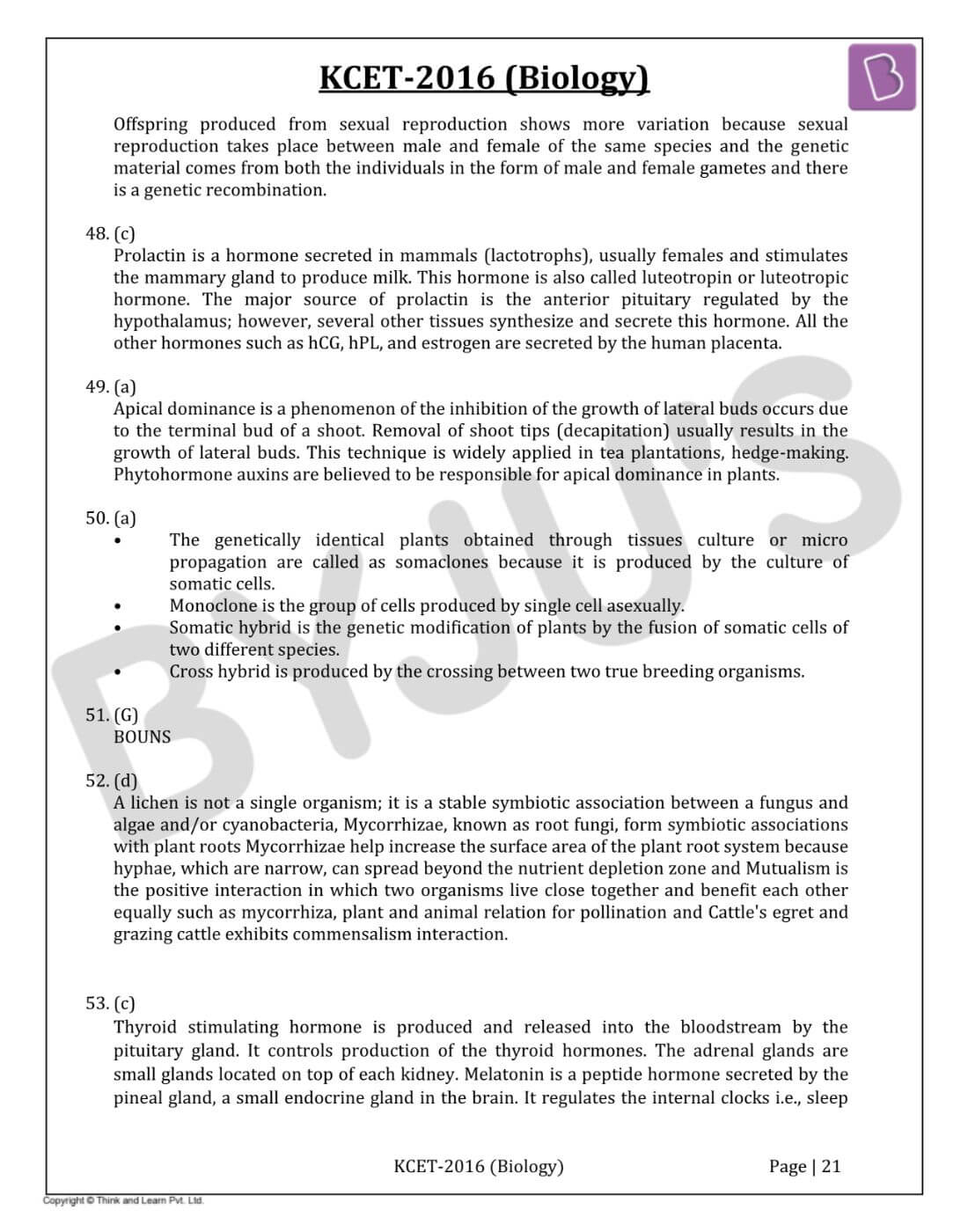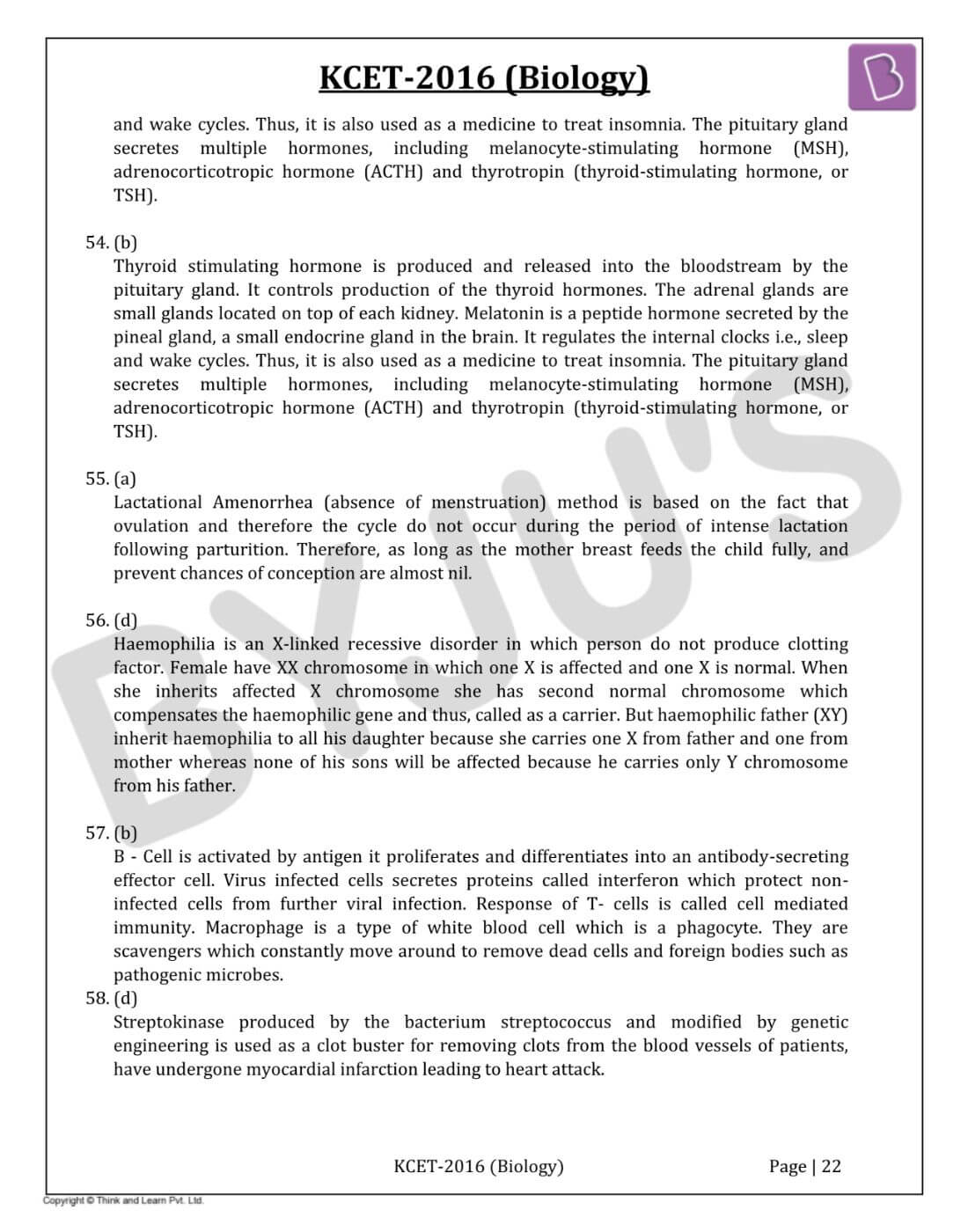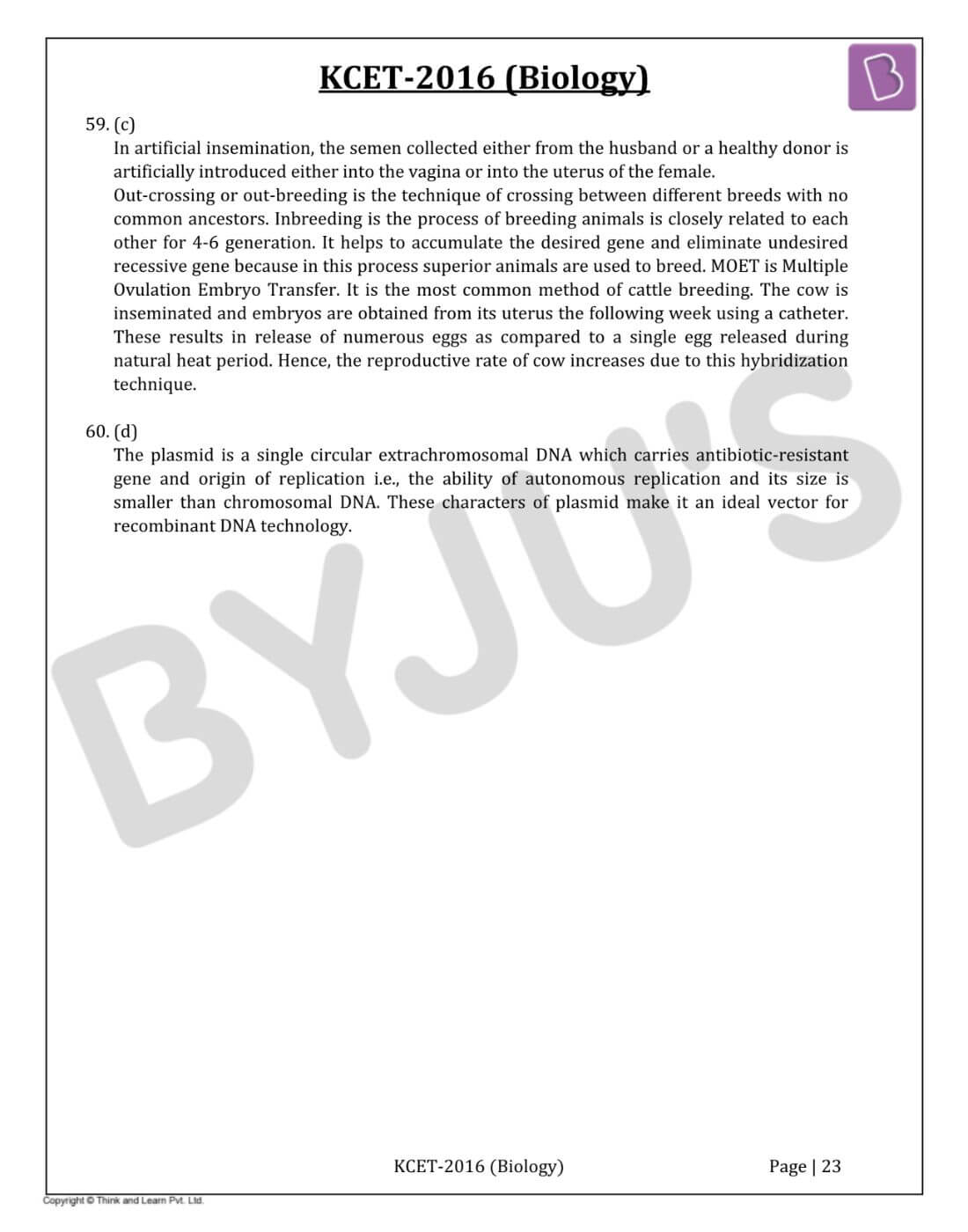Karnataka Examination Authority (KEA) conducts the Karnataka Common Entrance Test (KCET) every year for admission into various courses in the state of Karnataka. We have included all the questions asked in the KCET 2016 Biology paper with solutions on this page. One way to study productively for KCET is by solving previous years’ question papers. Doing this will help candidates understand the coverage of topics as well as the overall exam pattern for the upcoming exam.
KCET 2016 - Biology
1. In a taxonomic hierarchy, the number of common characters will increase as we go from
- a. Species to Kingdom
- b. Kingdom to Species
- c. Class to Order
- d. Genus to Species
Solution:
Answer: (b)
As we go higher from species to kingdom, the number of common characteristics goes on decreasing or vice versa. Lower the taxa more are the characteristics that the members within the taxon share. Higher the category, greater is the difficulty of determining the relationship to other taxa at the same level.
2. Which one of the following statement is correct?
- a. Chasmogamous flowers always exhibit geitonogamy.
- b. Cleistogamous flowers always exhibit autogamy.
- c. Chasmogamous flowers never exhibit autogamy.
- d. Cleistogamous flowers exhibit both autogamy and geitonogamy.
Solution:
Answer: (b)
Cleistogamous flowers do not open at all. In such flowers, the anther and stigma lie close to each other. When anthers dehisce in the flower buds, pollen grain comes in contact with the stigma to effect pollination. Thus, cleistogamous flowers are invariably autogamous as there is no chance of cross pollen landing on the stigma. Whereas chasmogamous flowers(with exposed anthers and stigma) can exhibit autogamy, geitonogamy or xenogamy.
3. E. coli bacteria grew in I5NH4Cl medium for several generations are allowed to grow in 14NH4Cl medium. After 2 generations, the bacteria are isolated from the medium and DNA of bacteria centrifuged in CsCI. The result of the density gradient of DNA is.
- a. only hybrid DNA
- b. both hybrid and heavy DNA
- c. both heavy and light DNA
- d. both hybrid and light DNA
Solution:
Answer: (d)
Stahl showed the semi-conservative mechanism of DNA replication. They cultured E. coli cells initially in a medium containing ammonium salts prepared with heavy nitrogen 15N15 to label, using all cellular DNA. Then cells were transferred to a medium containing the normal light isotope 14N14. DNA was analyzed by equilibrium density-gradient centrifugation in the periodically collected sample to separate heavy-heavy, light-light, and heavy-light duplexes into distinct bands. The sample was placed on a preformed gradient of cesium chloride. Centrifugation separates the macromolecules in different bands of density gradient which can be collected as a pure fraction. After the first generation, the density gradient contained only one band having H-L nitrogen. After the second generation, the density gradient contained 2 bands- one will have hybrid DNA and the other will have light DNA.
4. In which type of interaction, both the interacting organisms do not live close together?
- a. Predation
- b. Parasitism
- c. Mutualism
- d. Competition
Solution:
Answer:(d)
Predation is the consumption of one species (the prey) by another (the predator). Parasitism is a host parasite relationship in which one (parasite) is benefited while other (host) is adversely affected, although not necessarily killed. Competition is the injurious effect of one organism on another because of the removal of some resources of the environment. This phenomenon can result in major fluctuations in the composition of the microbial population in the soil
5. Facultative absorption of water from primary urine is influenced by the hormone
- a. Androgens
- b. Epinephrine
- c. Vasopressin
- d. Thyroxine
Solution:
Answer: (c)
Vasopressin, also known as antidiuretic hormone (ADH), is a neurohypophysial hormone found in most mammals. It plays an important role in the water balance (osmoregulation) of the body. When the fluid contents of the body become highly concentrated, ADH is secreted. This reaches the kidney via blood capillaries where it increases the permeability of the tubules thereby most of the water is reabsorbed and the urine gets concentrated with the reduction in volume. This hormone maintains the proper osmotic concentration of the blood plasma.
6. In a dithecous anther, each pollen sac contains 1000 MMC. What is the total number of pollen-grains produced by the anther?
- a. 4,000
- b. 8,000
- c. 16,000
- d. 32,000
Solution:
Answer: (c)
Total pollen sacs or microsporangia in bilobed, dithecous anther are four. Each pollen sac has 1000 microspore mother cells. So, total microspore mother cell in 4 pollen sacs is 4 × 1000 = 4000. Meiosis produces 4 pollen grains or male gametophytes. Meiosis in 400 microspore mother cell will produce = 400 × 4 = 1600 pollen grains or male gametophytes.
7. Identify the correct equation for Hardy-Weinberg law.
- a. p + q = 1
- b. p – q = 1
- c. (p + q)2 = 1
- d. (p – q)2 = 1
Solution:
Answer: (a,c)
It state that allele frequencies in a population are stable and is constant from generation to generation. The gene pool remains constant known as genetic equilibrium. Sum total of all the allele frequencies is 1.individual frequencies, for example, can be named p, q, etc. In a diploid, p and q represent the frequency of allele and allele a. The frequency of AA individual in a population is simply p2. This is simply stated in another ways, i.e. the probability that an allele A with a frequency of p appears on both the chromosomes of a diploid individual is simply the product of the probabilities, i.e. p2. Similarly of aa is q2 and of Aa is 2pq. Hence, (p + q)2 = 1 and when p2 represents the frequency of the homozygous genotype AA, q2 represents the frequency of the homozygous genotype aa, and 2pq represents the frequency of the heterozygous genotype Aa. In addition, the sum of the allele frequencies for all the alleles at the locus must be 1, so p + q = 1.
8. The relative contribution of various green house gases to total global warming is given in the following diagram

Identify the green house gases.
- a. A = CO2 ; B = CH4 ; C = CFCs ; D = N2O
- b. A = CO2 ; B = CFCs ; C = CH4 ; D = N2O
- c. A = CFCs ; B = CO2 ; C = CH4 ; D = N2O
- d. A = CFCs ; B = CH4 ; C = CO2 ; D = N2O
Solution:
Answer: (a)
The greenhouse effect is a naturally occurring phenomenon i.e. responsible for heating of earth surface and atmosphere. Greenhouse gases are gases that absorb and emit radiation within the thermal infrared range. Carbon dioxide contributes mostly to global warming which is followed by methane, nitrous oxide and CFC.
9. In plants, lateral roots arise from
- a. epidermis
- b. hypodermis
- c. endodermis
- d. pericycle
Solution:
Answer: (d)
The pericycle lies just inside the endodermis and is the outer most part of the stele of plants. Although, it is composed of non-vascular parenchyma cells, it is still considered part of the vascular cylinder because it arises from the procambium as do the vascular tissues it surrounds. In dicots, it also has the capacity to produce lateral roots. Branch roots arise from this primary meristem tissue. In plants undergoing secondary growth, the pericycle contributes to the vascular cambium often diverging into a cork cambium. Cortex, pith and endodermis do not give rise to lateral roots.
10. Find the sequence of binding of the following aminoacyl t-RNA complexes during translation to m-RNA transcribed by a DNA segment having the base sequences 3'TACATGGGTCCG5'

choose the answer showing the correct order of alphabets.
- a. A, B, D, C
- b. B, A, D, C
- c. C, D, B, A
- d. D, C, A, B
Solution:
Answer: (b)
The codon of the template strands of the DNA is transcribed into m-RNA by RNA polymerase. The transcribed m-RNA has complimentary bases with respect to its DNA template which is further assessed by the anticodon loop of t-RNA for base pairing during translation. If the DNA template has the codon with base sequence 3'TACATGGGTCCG5' the m-RNA codon will be AUGUACCCAGGC. The sequence of t-RNA codon will be UACAUGGGUCCG.
11. Match the plant structures given in the column-I with their plants given in the column-II.
|
Column-I |
Column-II |
|
A. Prothallus |
p. Bryophytes |
|
B. Microsporophyll |
q. Pteridophytes |
|
C. Protonema |
r. Angiosperms |
|
D. PEN |
s. Gymnosperms |
- a. A-r, B-p, C-s, D-q
- b. A-s, B-r, C-p, D-q
- c. A-q, B-s, C-r, D-p
- d. A-q, B-s, C-p, D-r
Solution:
Answer:(d)
The prothallus is the gametophyte of ferns i.e. present in pteridophytes. In most gymnosperms, the male pollen cones, called microstrobili, contain reduced leaves called microsporophylls. When a moss (bryophytes) first grows from the spore, it grows as a protonema which develops into a leafy gametophore. PEN, primary endosperm nucleus is present in angiosperm.
12. Snow blindness is caused due to
- a. Ozone hole
- b. Nuclear winter
- c. Acid rain
- d. Green house effect
Solution:
Answer: (a)
When ozone depletion is occurring widely in the stratosphere, the depletion is particularly marked over the Antarctica region. This has resulted in formation of a large area of thinned ozone layer, known as ozone hole. Snow blindness is the condition of loss of vision due to overexposure of UV light.
13. A person who has allergy, the type of antibody produced in his body is
- a. IgA
- b. IgG
- c. IgE
- d. IgM
Solution:
Answer: (c)
Immunoglobulin A (IgA), as the principal antibody class in the secretions that bathe these mucosal surfaces, acts as an important first line of defence. IgG is the main type of antibody found in blood and extracellular fluid, allowing it to control infection of body tissues.Immunoglobulin E (IgE) is antibodies produced by the immune system in response to the allergy. The immune system overreacted to the allergens and releases IgE. These antibodies travel to cells that release chemicals, causing an allergic reaction. This reaction usually causes symptoms in the nose, lungs, throat, or on the skin. IgM is the first antibody secreted by the adaptive immune system in response to a foreign antigen.
14. Elution means
- a. Separation of DNA fragments on agarose gel.
- b. Cutting and extraction of DNA bands from the agarose gel
- c. Making the DNA bands visible under UV radiation.
- d. Isolating alien DNA from the choice organism
Solution:
Answer: (b)
The separated bands of DNA are cut out from the agarose gel and extracted from the gel piece is known as elution.
15. The edible part of the fruit of apple is
- a. Thalamus
- b. Pericarp
- c. Endocarp
- d. Involucre
Solution:
Answer: (a)
False fruit or pseudocarp is derived from the accessory floral parts other than ovary. Apple is actually a false fruit. The main edible part of an apple is actually juicy receptacle of a flower i.e., thalamus. The other examples are peduncle in cashew nut, jackfruit, and pineapple. The pericarp develops from a plant’s ovary. It forms around the seeds. Depending on the fruit, only some layers of the pericarp are consumed. Guava and grapes are examples of fruits with edible pericarp. Not the pericarp but the fleshy thalamus is edible in pear because pear is a false fruit like apple. Endocarpis the innermost layer of the fruit which often develops into the pith.Involucre is whorl or rosette of bracts surrounding an inflorescence (especially a capitulum) or at the base of an umbel.
16. Identify a micro-organism that can produce biomass of protein.
- a. Monascuspurpureus
- b. Aspergillus niger
- c. Methylophilusmethylotrophus
- d. Trichoderma polysporum
Solution:
Answer: (c)
Monascuspurpureus have been commercialized as blood cholesterol lowering agents. Aspergillus Niger is a fungal microbe of great industrial importance. This mold is used extensively in the production of citric acid and in the production of several enzymes. Many species of bacteria have been investigated for use in single cell protein production. Methylophilusmethylotrophus has a generation time of about 2 hours and is usually and mainly used in animal feed as bacteria, in general produces a more favourable protein composition than yeast or fungi. Therefore the large quantities of single cell proteins animal feed can be produced using bacteria.
CyclosporinA that is used as immunosuppressive agents in organ transplantation patients is produced by the fungus Trichodermapolysporum.
17. What is the function of the enzyme ‘recombinase' during meiosis?
- a. Formation of synaptonemal complex
- b..Crossing over between non-sister chromatids
- c. Condensation of chromosomes
- d. Alignment of bivalent chromosomes on equatorial plate
Solution:
Answer: (b)
The synaptonemal complex begins to form during the zygotene phase of Prophase I in the first division in Meiosis.Recombinases are genetic recombination enzymes. These enzymes catalyze directionally sensitive DNA exchange reactions between short (30–40 nucleotides) target site sequences that are specific to each recombinase. Recombinase in meiosis helps in crossing over between non- sister chromatids in pachytene stage. Condensation of chromatin occurs during the prophase stage. In meiotic cell division, the mother cell divides twice after one round of replication. In meiosis, condensation occurs during prophase I which is long and complex stage. Condensation also occurs in prophase II, even though prophase II is not elaborate as prophase I.In Metaphase I bivalent chromosomes align on the equatorial plate. The microtubules from the opposite poles of the spindle attach to the kinetochore of homologous chromosomes.
18. Identify from the following group of animals, which exhibit oestrous cycle.
- a. Lion, deer, dog and cow
- b. Cow, monkey, elephant and ape
- c. Monkey, ape, man and elephant
- d. Lion, dog, monkey and ape
Solution:
Answer: (a)
Oestrous cycle is a reproductive cycle of females of non-primate vertebrates. The gap between two oestrus periods is known as estrous cycle. The females are highly receptive during oestrus period. It is an indication of breeding period because one or more periods of estrus may occur during the breeding season of a species. Some animals like dogs are monoestrous as they have only one estrous phase in their breeding cycle. Males can recognize a female in heat by smell of pheromones. Lion, deer, dog and cow are non- primates which exhibit oestrus cycle.
19. The codons UUU and UUC codes for phenylalanine only. This feature of genetic code is called
- a. commaless
- b. non-overlapping
- c. degenerate
- d. non-ambiguous
Solution:
Answer: (c)
NOTE- OPTION d IS REPLACED BY c.
Successive codons that is contiguous and not separated by noncoding bases or groups of bases. Most eukaryotic genes contain coding regions called exons interrupted by noncoding regions called introns, and in these situations the code is said to contain commas. A non-overlapping code means that the same letter is not used for two different codons. In other words, no single base can take part in the formation of more than one codon. When the multiple codons code for a single amino acid it is known as the degeneracy of code. This feature of the genetic code is called degenerate. Non-ambiguous code means that there is no ambiguity about a particular codon. While the same amino acid can be coded by more than one codon (the code is degenerate), the same codon shall not code for two or more different amino acids.
20. One of the following area is an example for secondary succession, if the succession takes place in/on
- a. abandoned farm land
- b. newly cooled lava
- c. newly created pond
- d. bare rock
Solution:
Answer: (a)
Primary succession takes place in a newly formed area like new ponds and bare rocks and the areas where the soil is unable to develop sustainable lives like newly cooled lava and retreated glacier areas. Secondary succession occurs in the areas where there occurred some natural disasters like hurricane, forest fire which reduces the ecosystem. It includes abandoned farm lands.
21. A doctor identifies symptoms of nasal congestion, headache, sore throat, hoarseness, coughing a patient. The conclusion is that, the patient is infected by a pathogen
- a. Adeno virus
- b. Rhino virus
- c. Plasmodium
- d. Salmonella
Solution:
Answer: (b)
Adenoviruses are a group of viruses that can infect the membranes of the respiratory tract, eyes, intestines, urinary tract, and nervous system. Rhinoviruses cause upper respiratory tract infections, but may also infect the lower respiratory tract. RVs are the most common cause of the common cold. Malaria is caused by Plasmodium parasites. Salmonella infection is a common bacterial disease that affects the intestinal tract.
22. The puffed-up appearance of dough is due to fermentation by bacteria. Identify the gas liberated during the process.
- a. Methane
- b. Carbon dioxide
- c. Hydrogen sulphide
- d. Ammonia
Solution:
Answer: (b)
When the bread is prepared yeast is added to it for porosity. The puffed up appearance of dough is due to fermentation by bacteria. During this process carbon dioxide is released.
23. Most suitable method of introducing alien DNA into a plant cell is
- a. biolistics
- b. microinjection
- c. lipofection
- d. heat shock method
Solution:
Answer: (a)
Biolistics is a method for the delivery of nucleic acid to cells by high-speed particle bombardment. Microinjection is a technique of delivering foreign DNA into a living cell. Lipofection is a technique used to inject genetic material into a cell by means of liposomes, which are vesicles that can easily merge with the cell membrane since they are both made of a phospholipid bilayer. E.coli using the heat shock method is a basic technique of molecular biology. It consists of inserting a foreign plasmid or ligation product into bacteria.
24. Which one of these is not an accessory gland in male reproductive system?
- a. Prostate gland
- b. Seminalvesicle
- c. Cowper's gland
- d. Bartholin's gland
Solution:
Answer: (d)
Prostate gland, seminal vesicle and Cowper gland are accessory glands. Bartholin's gland is not an accessory gland in male reproductive system. It is present in females. It is located slightly posterior and to the left and right of the opening of the vagina. Bartholin's glands secrete mucus to provide vaginal lubrication.Male accessory glands in humans are the seminal vesicles, prostate gland, and the Cowper's gland (also called as bulbourethral glands). These glands secrete fluid for the nourishment of sperms.
25. Find the mismatch from the following pairs:
- a. Divergent evolution→ thorn of bougainvillia and tendril of cucurbita
- b. Adaptive radiation →Australian marsupials
- c. Natural selection →Industrial melanism
- d. Genetic drift → Constant gene frequency
Solution:
Answer: (d)
In divergent evolution, two or more distinct species share a common ancestor from which they diverged. They share a common ancestor and yet evolved into two different species. A common example is thorn of bougainvillea and tendril of cucurbita. Adaptive radiation is a process in which organisms diversify rapidly from an ancestral species into a multitude of new forms, particularly when a change in the environment makes new resources available, creates new challenges, or opens new environmental niches. A number of marsupials (pouched mammals) each evolved differently from an ancestral stock but all within the Australian continent. Industrial melanism is a natural adaptation where the moths living in the industrial areas developed melanin pigment to hide themselves from their predators. Genetic drift describes random fluctuations in the numbers of gene variants in a population.It takes place when the occurrence of variant forms of a gene, called alleles, increases and decreases by chance over time. So, the gene frequency keeps on changing and is not constant.
26. What is the role of competitive inhibitor during enzyme action?
- a. It enhances enzyme action.
- b. It declines the enzyme action.
- c. It alters the active site of the enzyme and prevents the binding of substrate.
- d. It inhibits breaking of chemical bonds of the substrate.
Solution:
Answer: (b)
In competitive inhibition, a molecule similar to substrate competes with the substrate for the active site. Such molecules are known as an inhibitor. The presence of the inhibitor decreases availability of the active site for the substrate and further decreases the rate of reaction.
27. Some of the events occur during life cycle of plasmodium are given below. Identify the correct statement.
- a. The sporozoites reproduce sexually in liver cells.
- b. The gametocytes develop in RBC.
- c. Female mosquito takes up sporozoites with blood meal.
- d. When mosquito bites a man, gametocytes are injected.
Solution:
Answer: (b)
Plasmodium infection in humans begins when an infected Anopheles sp. mosquito takes a blood meal and injects infective sporozoites into the peripheral circulation. Within minutes, these sporozoites invade hepatocytes in the liver and, over approximately one week, undergo asexual multiplication, producing tens of thousands of merozoite forms of the parasite and released into the peripheral circulation. The merozoites invade red blood cells (RBCs) and complete another round of multiplication within 48–72 h, with the production of 16–20 additional merozoites per RBC, which devour the RBC hemoglobin in the process. Merozoites differentiate into male and female sexual forms. These sexual forms are taken from the bloodstream by a feeding Anopheles sp. mosquito and fertilize in the mosquito midgut to form zygotes. These zygotes further differentiate into motile forms, called ookinetes, migrate through the mosquito gut wall and divide within oocysts on the external gut wall to form thousands of sporozoites.
28. Read the following statements carefully and choose the correct statements:
a. In a transcription unit, the promoter located at the 5’ end of coding strand.
b. The single strand DNA having the polarity 5’→ 3’ is the template strand.
c. RNA polymerase binds to the operator during transcription.
d. single base DNA differences occur in humans are called Single Nucleotide Polymorphism (SNPs).
- a. Statements a and b
- b. Statements b and c
- c. Statements b and d
- d. Statements a and d
Solution:
Answer: (d)
Transcription is the process of formation of RNA from the DNA. In this process, only one strand of DNA is used called as template strand which has polarity 3' to 5'. The segment of DNA that takes part in transcription is called as transcription unit in which have promoters at the 5' end of coding or 3' end of template strand, structural gene and then terminator sequence. The promoter provides the binding site to the RNA polymerase enzyme for transcription. The single base DNA difference in the human genome is called as single nucleotide polymorphism.
29. Amniocentesis is one of the methods
- a. adapted for MTP
- b. of birth control
- c. for foetal sex determination
- d. used for safe parturition
Solution:
Answer: (c)
Amniocentesis is a medical term used when doctors remove fluid from the uterus of a pregnant woman for testing. The fluid withdrawn is called amniotic fluid which contains foetal cells and different chemicals from the baby. MTP is the medical termination of pregnancy, which is an abortion of the fetus through sex determination by amniocentesis, but not permitted by law because of its misuse.
30. Connel's field experiment on the rocky sea coast of Scotland, where larger Barnacle balanus dominates the intertidal area and removes the smaller Barnacle cathamalus. This happened due to
- a. Predation
- b. Competition
- c. Parasitism
- d. Mutualism
Solution:
Answer.(b)
Connel's experiment explained that two species of barnacles live in a stratified distribution in the intertidal region along the Scottish coast. Balanus is observed to be most concentrated in the lower intertidal area whereas Chthamalus is observed to be most concentrated in the upper intertidal area. In experiment 1, Connell removed Chthamalus from the upper area, and no balanus replaced it. This showed that balanus could not survive in an area with low tides. In experiment 2, Connell removed Balanus from the lower area and Chthamalus replaced it. This showed that balanus was a more successful competitor in the lower intertidal zone. This showed that competition is occurring between Chthamalus and Balanus.
31. Choose the incorrect statement from the following.
- a. Tendons attach muscle to bone.
- b. Ciliated epithelium is the modified columnar epithelium.
- c. Adipose tissue is a type of dense connective tissue.
- d. Cartilage is made up of chondrocytes.
Solution:
Answer: (c)
Tendons, which attach skeletal muscles to bones and ligaments which attach one bone to another. In ciliated epithelium, columnar epithelial tissues have cilia, then they are ciliated epithelium. They are present in the lining of the trachea, kidney tubules, etc. The rhythmic movement of the cilia helps in the movement of material in one direction. Adipose tissue is a specialized connective tissue consisting of lipid-rich cells called adipocytes. Cartilage is composed of specialized cells called chondrocytes that produce a large amount of collagenous extracellular matrix, abundant ground substance that is rich in proteoglycan and elastin fibers.
32. Desired genes have been introduced into transgenic animals to obtain large scale production of useful biological products encoded by these genes. This approach is generally referred to as
- a. hybridoma technology
- b. molecular farming
- c. gene therapy
- d. downstream processing
Solution:
Answer: (b)
Hybridoma technology is the production of monoclonal antibodies. Monoclonal antibodies are made outside the body by hybrid cells culture known as hybridomas. Molecular farming is an application of genetic engineering in which desired genes from human or animal origin are introduced into plants or animals for getting cost effective production of therapeutic products such as hormones, recombinant vaccines, antibodies etc. Gene therapy means altering the genotype of a cell or tissue or even whole organism to correct a genetic disorder, by placing normal gene in place of defective or malfunctioned gene. Downstream processing is the stages of separation and purification of products obtained after fermentation or any other biotechnological process.
33. A plant is provided with ideal conditions for photosynthesis and supplied with isotope 14CO2. When the products of the process are analysed carefully, what would be the nature of products?
- a. Both glucose and oxygen are labelled.
- b. Only oxygen is labelled but glucose is normal.
- c. Both glucose and oxygen are normal.
- d. Only glucose is labelled and oxygen is normal.
Solution:
Answer: (d)
• Oxygen will not be labelled and is normal as the supplied oxygen is normal as well.
• Glucose will be labelled as the carbon that forms it will be derived from the carbon dioxide supplied which is the supplied isotope.
• Glucose will be labelled.
• Glucose will be labelled as the carbon that forms it will be derived from the carbon dioxide supplied which is the supplied isotope. Oxygen will not be labelled and is normal as the supplied oxygen is normal as well.
34. Which among these is not a post fertilization event?
- a. Gametogenesis
- b. Embryogenesis
- c. Fruit formation
- d. Seed formation
Solution:
Answer: (a)
During pre-fertilization events of sexual reproduction prior to the fusion of gametes. The two main pre- fertilization events are gametogenesis and gamete transfer. Gametogenesis is the process of formation of gametes for fertilization. Post fertilization is the events occurred after the process of fertilization such as Embryogenesis, seed formation and fruit formation. Embryogenesis refers to the process of developments of embryo from the zygote. During seed formation the female and the male gamete merge to produce a diploid zygote. A series of post fertilization events take place in the zygote, and a seed develops. Flower acts as a carrier of seeds. The formation of the seed occurs in the ovule, a fruit develops inside an ovary that forms in flowers.
35. Sarcomere is the functional unit of contraction in a muscle fibre. Identify the portion of myofibril that constitutes a sarcomere.
- a. The portion of myofibril between two successive 'Z' line.
- b. The portion of myofibril between two successive 'I' band.
- c. The portion of myofibril between two successive 'A' band.
- d. The portion of myofibril between two successive 'M' line.
Solution:
Answer:(a)
In the centre of each ‘I’ band is an elastic fibre called ‘Z’ line which bisects it. The thin filaments are firmly attached to the ‘Z’ line. The thick filaments in the ‘A’ band are also held together in the middle of this band by a thin fibrous membrane called ‘M’ line. The ‘A’ and ‘I’ bands are arranged alternately throughout the length of the myofibrils. The portion of the myofibril between two successive ‘Z’ lines is considered as the functional unit of contraction and is called a sarcomere.
36. Some desert beetles can survive on "metabolic water", without ever drinking liquid water which
- a. Was produced as water in the organisms they eat.
- b. Is absorbed from the air along with respiratory oxygen.
- c. Is a breakdown product of pyruvate inside the mitochondria, along with carbon dioxide.
- d. Is a breakdown product from glycolysis in the cytoplasm.
Solution:
Answer: (c,d)
• Metabolic water is created by oxidizing the energy-containing substances in their food during metabolic activity. Some animals living in the desert are exclusively on metabolic water. They absorb this metabolic water from the air along with the respiratory oxygen.Metabolic water refers to water created inside a living organism through their metabolism, by oxidizing energy-containing substances in their food.
• During respiration, glucose is respiratory substrate and in the presence of oxygen the breakdown of substrate into carbon dioxide, water and ATP. So, some desert beetles can survive on metabolic water without ever drinking liquid water because it is a breakdown product from glycolysis in the cytoplasm.
37. The gene disorder phenylketonuria is an example for
- a. Polygenic inheritance
- b. Pleiotropy
- c. Multiple allelism
- d. Multiple factor
Solution:
Answer:(b)
• Polygenic inheritance occurs when one characteristic is controlled by two or more genes. Often the genes are large in quantity but small in effect. Examples of human polygenic inheritance are height, skin color, eye color and weight.
• Pleiotropy is a condition when one gene controls two or more unrelated traits. Phenylketonuria (PKU) is an inborn error of metabolism that results in decreased metabolism of the amino acid phenylalanine. So, the gene disorder phenylketonuria is an example of pleiotropy.
• Multiple allelism is the condition wherein three or more alleles of a gene are present. Thus, the term multiple alleles pertain to the presence of three or more alleles for a particular gene. It is best illustrated by the ABO blood group system in humans.
• A multiple is a number that can be divided by another number a certain number of times without a remainder. A factor is one of two or more numbers that divides a given number without a remainder.
38. A population is correctly defined as having which of the following characteristics?
a. Inhabiting the same geography area
b. Individuals belonging to same species
c. Possessing a constant and uniform density and dispersion
- a. a and b only
- b. b and c only
- c. a and c only
- d. b only
Solution:
Answer: (a)
A population is defined as the number of organisms of the same species that live in a particular geographic area at the same time, with the capability of interbreeding.
39. Choose the correct sequence of events occur in human reproduction.
- a. Gametogenesis→gestation →insemination → fertilization →implantation→parturition
- b. Gametogenesis→ insemination→gestation → implantation →fertilization → parturition
- c. Gametogenesis→ insemination →fertilization →implantation → gestation→ parturition
- d. Gestation →gametogenesis →insemination →implantation →fertilization →parturition
Solution:
Answer: (c)
• Gametogenesis is a process of formation of gametes by the germ cells of the reproductive organs. They undergo mitotic and meiotic division to form a functional gamete.
• Insemination is the introduction of sperm into a female animal or plant for the purpose of impregnating or fertilizing the female for sexual reproduction.
• Fertilization is the union of a human egg and sperm, usually occurring in the ampulla of the fallopian tube. The result of this union is the production of a zygote cell, or fertilized egg, initiating prenatal development.
• Implantation is the very early stage of pregnancy at which the developing embryo adheres to the wall of the uterus.
• Gestation is the process or period of developing inside the womb between conception and birth.
• Parturition is the action of giving birth to young ones.
40. In a polysaccharide, number of monosaccharides is linked by
- a. peptide bond
- b. phosphoester bond
- c. glycosidic bond
- d. hydrogen bond
Solution:
Answer: (c)
Peptide bonds are formed between amino acids by linking them into long chains called proteins.
The bond formed between the sugar and the phosphate group is a phosphoester bond.
Glycosidic bonds are formed between simple monosaccharides and join them to make large polysaccharides.Polysaccharides are polymers of simple sugars. In polysaccharides, many units of simple sugars are joined together by glycosidic bond. Polysaccharides can be storage polysaccharides, e.g., starch and glycogen or structural polysaccharides, e.g., cellulose depending on their function.
Tiny forces called hydrogen bonds hold the glucose molecules together and the chains in close proximity.
41.'A' and 'B’ are the two adjacent living cells. The cell 'A' has solute potential (ᴪs) of – 9 bars and pressure potential (ᴪp) of 4 bars, whereas cell ‘B’ has solute potential (ᴪs) of – 8 bars and pressure potential (ᴪp) of 5 bars. What will be the direction of water movement between these cells?
- a. Cell A to Cell B
- b. Cell B to Cell A
- c. Do not move in any direction
- d. Moves in both the directions
Solution:
Answer: (b)
CELL ‘A’ CELL ‘B’
Solute potential = -9 bars Solute potential = -8 bars
Pressure potential = 4 bars Pressure potential = 5 bars
Water potential (Ψ) is actually determined by taking into account two factors - osmotic (or solute) potential (ΨS) and pressure potential (ΨP). The formula for calculating water potential is Ψ = ΨS + ΨP. So, ΨA = –9 + 4 = –5 and ΨB= –8 + 5 = –3. The direction of water movements between these cells is “Cells B to Cell A”.
42. Which one of the following statement is wrong with respect to separation of DNA fragments on gel electrophoresis?
- a. The DNA fragments move towards anode under electric field through the matrix.
- b. The commonly used matrix is agarose gel.
- c. The DNA fragments resolve according to their size.
- d. The smaller DNA fragments separate first.
Solution:
Answer: bonus
43. The rate of formation of new organic matter by deer in a forest ecosystem is called
- a. Primary productivity
- b. Secondary productivity
- c. Standing crop
- d. Net Primary productivity
Solution:
Answer: (b)
• Primary productivity is the rate at which energy is converted by photosynthetic and chemosynthetic autotrophs to organic substances.
• The rate at which the consumers convert the chemical energy of their food into their own biomass is called secondary productivity.
• A standing crop is the total dried biomass of the living organisms present in a given environment.
• Net primary production is the rate at which all the plants in an ecosystem produce net useful chemical energy.
44. Digestion of proteins is incomplete in the absence of enterokinase, because
- a. Pepsinogen is not converted into pepsin.
- b. Chymotrypsinogen is not converted into chymotrypsin.
- c. Trypsinogen is not converted into trypsin.
- d. Prorennin is not converted into rennin.
Solution:
Answer:(c)
Enterokinase is an enzyme secreted by duodenum of the small intestine and involves in the digestion of food. It converts trypsinogen to active trypsin which digests protein into amino acids and completes the digestion of protein. But in the absence of enterokinase trypsinogen is not converted into the trypsin and thus the digestion of protein will be incomplete.
45. The primary treatment of sewage water involves
- a. sludge digestion
- b. aerobic bacterial activity
- c. anaerobic bacterial activity
- d. filtration and sedimentation
Solution:
Answer:(d)
Primary treatment of sewage basically involves the physical removal of large and small particles, through filtration and sedimentation. This is done in many stages. Initially, floating debris is removed by sequential filtration and then the grit i.e. soil and small pebbles, is removed by sedimentation. All the solids that settle down forms the primary sludge and the supernatant form the effluent. The effluent from the primary settling tank is further taken for secondary treatment.
46. From the following pedigree chart of a family, one can make an analysis that,

- a. It is an autosomal dominant trait.
- b. It is an autosomal recessive trait.
- c. It is an allosomal dominant trait.
- d. It is an allosomal recessive trait.
Solution:
Answer: (b)

When neither parent is affected but producing affected offspring then they must be heterozygous and hence this disorder will be autosomal recessive. Such disorder appears more frequently among the children of marriage between closely related individual.
47. Offsprings formed during sexual reproduction exhibits more variation than those formed by asexual method, because
- a. Genetic material comes from two different individuals.
- b. Greater amount of DNA is involved.
- c. Sexual reproduction is more complicated
- d. Genetic material comes from male parent
Solution:
Answer: (a)
Offspring produced from sexual reproduction shows more variation because sexual reproduction takes place between male and female of the same species and the genetic material comes from both the individuals in the form of male and female gametes and there is a genetic recombination.
48. Pick the hormone which is not secreted by human placenta.
- a. hCG
- b. hPL
- c. Prolactin
- d. Estrogen
Solution:
Answer: (c)
Prolactin is a hormone secreted in mammals (lactotrophs), usually females and stimulates the mammary gland to produce milk. This hormone is also called luteotropin or luteotropic hormone. The major source of prolactin is the anterior pituitary regulated by the hypothalamus; however, several other tissues synthesize and secrete this hormone. All the other hormones such as hCG, hPL, and estrogen are secreted by the human placenta.
49. The phenomenon called 'Apical dominance' in plants is due to a phytohormone
- a. Auxins
- b. Gibberellins
- c. Cytokinins
- d. ABA
Solution:
Answer:(a)
Apical dominance is a phenomenon of the inhibition of the growth of lateral buds occurs due to the terminal bud of a shoot. Removal of shoot tips (decapitation) usually results in the growth of lateral buds. This technique is widely applied in tea plantations, hedge-making. Phytohormone auxins are believed to be responsible for apical dominance in plants.
50. Plants obtained through tissue culture are genetically identical and they are obtained by somatic cells. What do you call them?
- a. Somaclones
- b. Monoclones
- c. Somatic hybrids
- d. Cross hybrids
Solution:
Answer: (a)
• The genetically identical plants obtained through tissues culture or micro propagation are called as somaclones because it is produced by the culture of somatic cells.
• Monoclone is the group of cells produced by single cell asexually.
• Somatic hybrid is the genetic modification of plants by the fusion of somatic cells of two different species.
• Cross hybrid is produced by the crossing between two true breeding organisms.
51. A human male is heterozygous for autosomal genes 'A' and 'B'. He is also hemizygous for haemophilic gene 'h'. What percentage of sperms will carry 'abh' genotype?
- a. 25%
- b. 50%
- c. 75%
- d. 0%
Solution:
Answer: BONUS
52. All the following interactions are mutualism, except
- a. association of algae and fungi in lichens
- b. association of fungi and roots of higher plants in mycorrhiza
- c. plant and animal relation for pollination
- d. association of cattle egret and grazing cattle
Solution:
Answer: (d)
A lichen is not a single organism; it is a stable symbiotic association between a fungus and algae and/or cyanobacteria, Mycorrhizae, known as root fungi, form symbiotic associations with plant roots Mycorrhizae help increase the surface area of the plant root system because hyphae, which are narrow, can spread beyond the nutrient depletion zone and Mutualism is the positive interaction in which two organisms live close together and benefit each other equally such as mycorrhiza, plant and animal relation for pollination and Cattle's egret and grazing cattle exhibits commensalism interaction.
53. The hormone ‘melatonin' is secreted by the gland
- a. Thyroid
- b. Adrenal
- c. Pineal
- d. Pituitary
Solution:
Answer: c
Thyroid stimulating hormone is produced and released into the bloodstream by the pituitary gland. It controls production of the thyroid hormones. The adrenal glands are small glands located on top of each kidney.Melatonin is a peptide hormone secreted by the pineal gland, a small endocrine gland in the brain. It regulates the internal clocks i.e., sleep and wake cycles. Thus, it is also used as a medicine to treat insomnia. The pituitary gland secretes multiple hormones, including melanocyte-stimulating hormone (MSH), adrenocorticotropic hormone (ACTH) and thyrotropin (thyroid-stimulating hormone, or TSH).
54. A scrubber in the exhaust of a chemical industry removes
- a. hydrogen sulphide
- b. sulphur dioxide
- c. nitrous oxide
- d. carbon monoxide
Solution:
Answer:. b
Thyroid stimulating hormone is produced and released into the bloodstream by the pituitary gland. It controls production of the thyroid hormones. The adrenal glands are small glands located on top of each kidney.Melatonin is a peptide hormone secreted by the pineal gland, a small endocrine gland in the brain. It regulates the internal clocks i.e., sleep and wake cycles. Thus, it is also used as a medicine to treat insomnia. The pituitary gland secretes multiple hormones, including melanocyte-stimulating hormone (MSH), adrenocorticotropic hormone (ACTH) and thyrotropin (thyroid-stimulating hormone, or TSH).
55. Lactational amenorrhea
- a. prevents secretion of milk from breast
- b. prevents conception
- c. prevents secretion of prolactin
- d. prevents spermatogenesis
Solution:
Answer: (b)
Lactational Amenorrhea (absence of menstruation) method is based on the fact that ovulation and therefore the cycle do not occur during the period of intense lactation following parturition. As a result chances of conception are almost nil as long as the mother lactates fully.
56. The gene for haemophilia is located on 'X' chromosome. Hence it is normally impossible for a
- a. Haemophilic father to pass the gene to his daughter
- b. Carrier mother to pass the gene to her daughter
- c. Carrier mother to pass the gene to her son
- d. Haemophilic father to pass the gene to his son
Solution:
Answer: (d)
Haemophilia is an X-linked recessive disorder in which person do not produce clotting factor. Female have XX chromosome in which one X is affected and one X is normal. When she inherits affected X chromosome she has second normal chromosome which compensates the haemophilic gene and thus, called as a carrier. But haemophilic father (XY) inherit haemophilia to all his daughter because she carries one X from father and one from mother whereas none of his sons will be affected because he carries only Y chromosome from his father.
57. Identify the incorrect statement from the following.
- a. B-cells produce antibody.
- b. Interferons kill viruses.
- c. Response of T-cells is called cell mediated immunity.
- d.Macrophages are the phagocytic cells.
Solution:
Answer: (b)
B - Cell is activated by antigen it proliferates and differentiates into an antibody-secreting effector cell. Virus infected cells secretes proteins called interferon which protect non- infected cells from further viral infection. Response of T- cells is called cell mediated immunity. Macrophage is a type of white blood cell which is a phagocyte. They are scavengers which constantly move around to remove dead cells and foreign bodies such as pathogenic microbes.B - Cell is activated by antigen it proliferates and differentiates into an antibody-secreting effector cell. Virus infected cells secretes proteins called interferon which protect non- infected cells from further viral infection. Response of T- cells is called cell mediated immunity. Macrophage is a type of white blood cell which is a phagocyte. They are scavengers which constantly move around to remove dead cells and foreign bodies such as pathogenic microbes.
58. A person admitted to hospital as he had myocardial infarction. A cardiologist injecting him ‘streptokinase', why?
- a. It reduces hypertension.
- b. It reduces the level of blood cholesterol.
- c. It stimulates heart beat.
- d. It acts as clot buster.
Solution:
Answer:(d)
Streptokinase produced by the bacterium streptococcus and modified by genetic engineering is used as a clot buster for removing clots from the blood vessels of patients, have undergone myocardial infarction leading to heart attack.
59. One of the breeding techniques useful to eliminate harmful recessive genes by selection is
- a. Artificial insemination
- b. Out-breeding
- c. In-breeding
- d. MOET
Solution:
Answer: (c)
In artificial insemination, the semen collected either from the husband or a healthy donor is artificially introduced either into the vagina or into the uterus of the female.
Out-crossing or out-breeding is the technique of crossing between different breeds with no common ancestors. Inbreeding is the process of breeding animals is closely related to each other for 4-6 generation. It helps to accumulate the desired gene and eliminate undesired recessive gene because in this process superior animals are used to breed. MOET is Multiple Ovulation Embryo Transfer. It is the most common method of cattle breeding. The cow is inseminated and embryos are obtained from its uterus the following week using a catheter. These results in release of numerous eggs as compared to a single egg released during natural heat period. Hence, the reproductive rate of cow increases due to this hybridization technique.
60. Which one of the following statements is not correct about a plasmid?
- a. It is a circular DNA.
- b. It has antibiotic resistant gene.
- c. It has the ability of autonomous replication.
- d. Its DNA is as long as chromosomal DNA.
Solution:
Answer: (d)
The plasmid is a single circular extrachromosomal DNA which carries antibiotic-resistant gene and origin of replication i.e., the ability of autonomous replication and its size is smaller than chromosomal DNA. These characters of plasmid make it an ideal vector for recombinant DNA technology.

